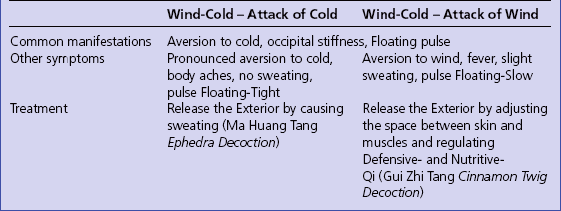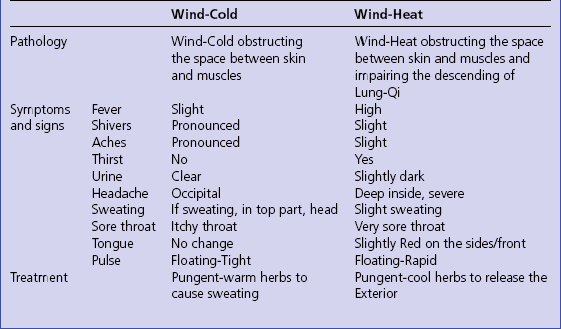Chapter 103 Wind is Yang in nature and tends to injure Blood and Yin. It is often the vehicle through which other climatic factors invade the body. For example, Cold will often enter the body as Wind-Cold and Heat as Wind-Heat. There is a saying that captures the clinical characteristics of Wind: ‘Sudden rigidity is due to Wind’.1 This refers to the clinical manifestations resulting from both interior and exterior Wind. In fact, interior Wind can cause paralysis (as in Wind-stroke) and exterior Wind can cause facial paralysis or simply stiffness of the neck. The main clinical manifestations of Wind are listed in Box 103.1. The symptoms and signs of invasion of exterior Wind are: Box 103.2 summarizes the patterns of exterior Wind invasion. These are the general symptoms of Wind-Cold. There are, however, two separate patterns of invasion of Wind-Cold: one with a predominance of Wind (called Attack of Wind) and the other with a predominance of Cold (called Attack of Cold). The former is more likely to occur when the patient’s Upright Qi is weak (and is treated with Gui Zhi Tang Ramulus Cinnamomi Decoction); the latter occurs when the patient’s Upright Qi is relatively strong (and is treated with Ma Huang Tang Ephedra Decoction). In Attack of Wind there is slight sweating, in Attack of Cold there is no sweating. Interior Wind is always related to a Liver disharmony. It can arise from three different conditions: 1. Extreme Heat Extreme Heat can give rise to Liver-Wind. This happens in the late stages of febrile diseases when the Heat enters the Blood portion and generates Wind. This process is like the wind generated by a large forest fire. The clinical manifestations are a high fever, delirium, coma and opisthotonos. These signs are frequently seen in meningitis and are due to Wind in the Liver and Heat in the Pericardium. 2. Liver-Yang Liver-Yang rising can produce Liver-Wind in prolonged cases. The clinical manifestations are severe dizziness, vertigo, headache and irritability. 3. Deficiency of Liver-Blood Finally, deficiency of Liver-Blood can also give rise to Empty Liver-Wind. This is due to the deficiency of Blood creating an empty space within the blood vessels, which is taken up by interior Wind. This could be compared to the draughts generated sometimes in certain underground (subway) stations. The clinical manifestations are numbness, dizziness, blurred vision, tics and slight tremors (in Chinese called ‘chicken feet Wind’ as the tremors are like the jerky movements of chickens’ feet when they are scouring the ground for food). Empty-Wind can also result from Liver-Yin deficiency. Box 103.3 summarizes the patterns of interior Wind.
 IDENTIFICATION OF PATTERNS ACCORDING TO PATHOGENIC FACTORS
IDENTIFICATION OF PATTERNS ACCORDING TO PATHOGENIC FACTORS
WIND
Exterior Wind
Wind-Cold
Interior Wind





